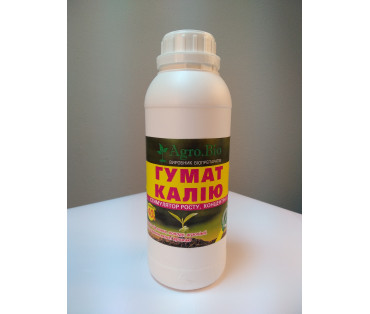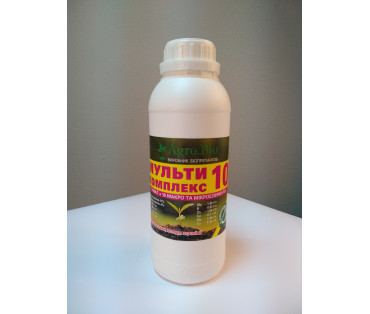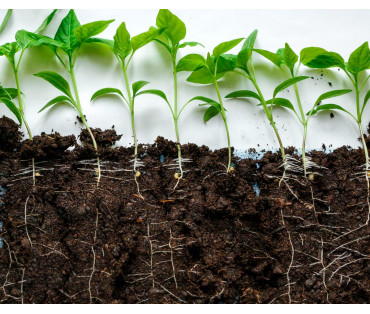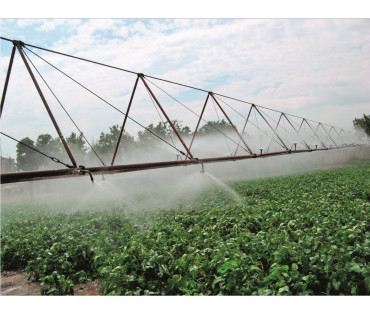Comparative efficiency of potassium humate and an equivalent set of mineral fertilizers
Trial batches of humic fertilizers were transferred for study and testing to our research center in the Kherson region.
We present the results of those field experiments that allow us to judge the correctness of the physiological principles of the technology of these fertilizers. First of all, such experiments will be those in which Potassium Humate + Phosphorus "Agro.Bio" is compared with an equivalent set of mineral and organic fertilizers. They were held in 2020 in our research center with tomatoes, and in 2021 with potatoes. An experiment with Potato under similar soil and climatic conditions was carried out in 2020 in the Golopristan district. Thus, according to this scheme, two-year data were obtained for both cultures.
Experiments with tomatoes were carried out using the following agricultural techniques: in the 2020 experiment, 3 quintals of superphosphate were applied under plowing , and 20 tons of manure and 3 quintals of superphosphate per hectare were given under the predecessor . In the spring, after cultivation, the field was marked 70 X 70 cm, fertilizer was applied to the holes, and on June 2, seedlings were planted in the ground.
In past years, it turned out that the optimal dose of Potassium Humate + Phosphorus "Agro.Bio" for foliar treatment was 2 l / ha . In this regard, it was introduced in such a norm .
Mineral fertilizers were calculated equivalent to the content of nitrogen and phosphorus in potassium humate, which was 0.6 g of ammonium sulfate and 0.8 g of superphosphate per nest. (The calculation was made by the amount of these substances, soluble in 0.5 n H 2 SO 4 ).
During the growing season, 7 irrigations and 7 loosenings were done. In 2021, the experimental plot has not been fertilized since autumn. Fertilization in the spring, as well as their calculation, was carried out in the same way as in 2020. In connection with the given content of N and P 2 O 5 in potassium humate this year, the equivalent amount of mineral fertilizers was 0.8 g of ammonium sulfate, and 1.4 g of superphosphate.
Tomato seedlings were planted on June 18 and during the growing season they gave 9 irrigations and carried out the same amount of loosening. These experiments with tomatoes were laid in 3 repetitions on plots of 70 m 2 in size , of which the accounting area was 62.5 m 2 . Due to the fact that during the years of experiments, seedlings were planted in the ground late, the effect of seed fertilizers on the development of plants affected only at the beginning of the formation of the ovary.
Thus, the calculation carried out on August 5, 2020 showed that the average number of ovaries per plant (out of 80 accounting) for individual options was as follows: control 1.9; potassium humate 1.2l/ha
equivalent to 2 l/ha - 2.6; peat 40 g per nest - 2.4; mechanical mixture of peat and NP is equivalent to potassium humate - 3.5 l/ha.
In 2021, the difference in growth was less noticeable. Harvesting was carried out in 2020: 4/08, 13/08, 23/08, 2/09, 8/09; in 2021 - 23/08, 31/08, 7/09, 14/09, 28/09.
Experiments with potatoes were laid on the site where the main fertilizer was not given. When planting, fertilizers were applied and calculated in the same way as for tomatoes. Potatoes were planted in 2020 on April 14, and in 2021, potatoes of a different variety were planted on April 19 in a square nest method. During the growing season in 2020, 3 irrigations were given for potatoes and 3 loosenings were done, and in 2021 2 irrigations and 4 loosenings were carried out. The repetition of the experiment in 2020 with a registration plot size of 25 m 2 was 4 times, and in 2021 with a size of 66 m 2 - 3-fold. Phenological observations on this experiment showed that shoots of potassium humate and peat appear much earlier than the control. So, in 2021, they appeared on the control on May 18, while for potassium humate on May 10, peat mixed with and without mineral fertilizers - on May 14-15
The applied fertilizers accelerated the flowering of plants. In the same year, the control plants bloomed on July 6, those fertilized with potassium humate on June 30. fertilized NP - July 4, and for peat mixed with mineral fertilizers - July 2.
Harvesting of potatoes in 2020 was carried out on August 30, in 2021 - on August 1.
Yield data for the experiment with potatoes are given in table. one.
From Table. Table 2, which shows the temperature data, shows that 2020, compared with many years, was distinguished by higher average temperatures, and 2021 by lower ones.
Table 1
Comparative efficiency of potassium humate and an equivalent set of mineral fertilizers and peat for potatoes
(Based on field experiments with potatoes 2020 and 2021)
|
Experience Scheme |
Yield per plot in kg by repetition |
Yield in c/ha |
Yield increase |
|||||
|
1st |
2nd |
3rd |
4th |
Medium |
c/g |
In % to control |
||
|
2020 control (without fertilization) ............... |
16.2 |
14.0 |
17.4 |
18.2 |
16.4 |
65.6 |
|
|
|
Humate Potassium + Phosphorus "Agro.Bio" 2l/ha. . . |
25.0 |
18.6 |
19.4 |
20.0 |
20.8 |
83.2 |
17.6 |
27 |
|
NP equivalent to 2l/ha potassium humate |
17.1 |
13.0 |
15.2 |
16.6 |
15.5 |
62.0 |
3.2 |
- |
|
Peat 40 g per nest .... |
16.0 |
20.4 |
18.0 |
17.0 |
17.9 |
71.6 |
6.0 |
9 |
|
Mechanical mixture of peat + NP is equivalent to 2l/ha of potassium humate ............... |
18.8 |
17.2 |
20.0 |
16.3 |
18.1 |
72.4 |
6.8 |
ten |
|
2021 Control (no fertilizer) |
43 |
42 |
43 |
|
42.6 |
65.6 |
|
|
|
Humate Potassium + Phosphorus "Agro.Bio" 2l/ha |
82 |
80 |
76 |
— |
79.3 |
119.9 |
54.3 |
83 |
|
NP equivalent to 2l/ha of potassium humate.................. |
48 |
52 |
51 |
|
50.4 |
75.6 |
10.0 |
fifteen |
|
Peat 40 g per nest .... |
66 |
58 |
66 |
— |
63.3 |
94.9 |
29.3 |
45 |
|
Mechanical mixture of peat - + NP is equivalent to 2l/ha of potassium humate .............. |
67 |
68 |
61 |
|
65.4 |
93.2 |
27.6 |
42 |
table 2
Average temperatures near Zelenovka village in 2020 and 2021 in degrees C.
|
years |
Maybe |
June |
July |
August |
September |
|
2020............. |
18.8 |
25.1 |
25.5 |
25.0 |
20.3 |
|
2021............. |
16.8 |
20.1 |
24.6 |
22.4 |
19.0 |
|
Average perennial |
17.3 |
22.4 |
24.2 |
23.5 |
18.1 |
Table 3
Precipitation near Zelenovka village in 2020 and 2021 in mm
|
years |
Total rainfall for the year |
By month |
||||
|
Maybe |
June |
July |
August |
September |
||
|
2020 |
358 |
53.7 |
24.1 |
40.1 |
1.0 |
13.3 |
|
2021 |
528 |
52.4 |
84.0 |
100.7 |
49.4 |
6.0 |
|
Average perennial |
348 |
31.6 |
52.0 |
30.0 |
25.2 |
18.7 |
An even sharper difference in precipitation. Table 3 shows that if 2020 in terms of total precipitation almost does not differ from the long-term average, then in June, July and August it almost did not rain at all. If we take into account that in the area of the village of Zelenkovka, due to their low water-retaining power, the decisive role in the development of plants is played not by the abundant annual moisture rate, but by the amount that falls during the growing season, it becomes clear that in 2020 the plants were placed in conditions severe soil drought. This year is also characterized by exceptionally strong air drought. So, the data at the Aleshenskaya meteorological station show that the relative humidity of the air dropped in the same months to 29-32. As for 2021, as can be seen from the same table, it differs, in comparison with the long-term average, increased humidity.
The data in the tables show that potassium humate, both in 2020 and in 2021, turned out to be more effective than not only an equivalent set of mineral fertilizers, but also their mixture with peat. The main difference between the last variant with potassium humate is the degree of solubility of humic acids, therefore, the difference in their effectiveness must be attributed to the action of this factor.
When analyzing these data, it should be taken into account that the peat that was introduced as controls in these experiments contained some amount of soluble humic acids, since its aqueous extract had a reaction close to neutral (in the experiments of 1955, pH = 6, eight).
It can be assumed that if peat with its lower content of soluble humic acids is taken as controls, then the relative efficiency of potassium humate will be even higher. In order to test this situation, another variant was included in the experiment with tomatoes in 2021, in which a mixture of mineral fertilizers with peat was applied, the water extract of which was brought to 6.2 by spraying with a weak solution of sulfuric acid. This mechanical mixture, when applied under tomatoes, gave an increase in yield of only 14%, while a mixture prepared from neutral peat increased the yield of tomatoes by 26%.
It is possible that conflicting data on the effectiveness of organomineral mixtures, which are often obtained if they are prepared from peat and superphosphate, are explained by the presence or absence of soluble humic and fulvic acids in them.
Due to the fact that during such a reaction, humic and fulvic acids dissolved in a larger amount than is necessary for a stimulating effect on plants, it is likely that such peat can only be treated with acid to obtain effective humic fertilizers.
When evaluating the quality of peat from the point of view of the expediency of using it as a raw material for the preparation of humic and fulvic fertilizers, it is necessary to attach importance not only to its reaction, but also to the content of calcium salts in it.
From the same tables 2 and 3 it can be seen that the degree of influence of all fertilizers on the yield of experimental crops in different years was different. This, first of all, must be associated with the level of agricultural technology at which the experiments were carried out, and with the meteorological conditions of the year.
Among the agrotechnical conditions, from this point of view, the main fertilizers and the number of irrigations should be put in the first place.
The sandy soils of the Lower Dnieper region are extremely poor in nutrients and, if they are not filled with a significant amount of the main fertilizer, then no fertilizers, which, as you know, are applied in small doses and are designed to improve nutritional conditions only in the initial period of the plant's life, cannot give a significant effect. .
This was the case with potatoes in 2020 and with tomatoes in 2021.
No less sharply affected the effectiveness of fertilizers and meteorological conditions. It was mentioned above that 2020 was extremely dry, but the tomato plants with which the experiment was carried out did not experience soil drought in 2020, since they received 11 vegetation irrigations at an irrigation rate of 300–350 m 3 , nor in 2021. when, although they gave less irrigation, more rain fell. Consequently, the tomatoes in the 2020 experiment experienced only air drought and higher summer temperatures. This leads to the conclusion that the higher efficiency of the tested fertilizers in 2020 is associated not only with the level of agricultural technology, but also with their effect on the ability of plants to tolerate air drought.
In the experiment with potatoes in 2020, the low increase in yield with all fertilizers, obviously, must be explained by the fact that only three irrigations were applied under this crop, and the plants suffered from soil drought, although potatoes in the 2021 experiment received more less irrigation, but this year was characterized by increased rainfall. It should be recalled that the amount of mineral fertilizers and peat, which is equivalent to their content in Potassium Humate + Phosphorus "Agro.Bio" , is significantly lower than the generally accepted norms of these fertilizers when sowing in the conditions of the Lower Dnieper.
The question arose whether this undesirable phenomenon could be avoided if only Amino Energy "Agro.Bio" was prepared and then applied together with granulated superphosphate. To answer it in 2020, another experiment was laid in our research center with summer planting tomatoes and potatoes, agricultural machinery, planting dates and methodology are the same as in the experiments described above this year at the same experimental station. The results of these experiments are in table. 4 .
The table shows that the combined application of Amino Energy "Agro.Bio" and granulated superphosphate in amounts equivalent to potassium humate had approximately the same result. The lower relative increase in humic fertilizers during the summer planting of potatoes, apparently, can be associated with the fact that it was carried out on lupine fallow, in which lupine was plowed only 2 weeks before planting potatoes. During its decomposition in the soil, the formation of mobile humic acids probably took place, due to which the effectiveness of humic fertilizers decreased.
Table 4
Comparative efficiency of potassium humate and Amino Energy "Agro.Bio" on sandy soils
(According to field experiments in 2020 in the Kherson region)
|
Experience Scheme |
Tomatoes |
summer planting potatoes |
||
|
yield in c/ha |
increase in % to control |
yield in c/ha |
increase in % to control |
|
|
Without fertilizer....... |
207 |
- |
105 |
- |
|
Potassium humate 2l/ha .... |
359 |
+73 |
120 |
+ 14 |
|
Amino Energy «Agro.Bio» 2 l / ha ....
|
206 |
+42 |
122 |
+16 |
|
Amino Energy + superphosphate equivalent to 2l/ha potassium humate |
318 |
+54 |
125 |
19 |
Note. Experience with the summer planting of potatoes was based on lupine fallow.
An even more detailed experiment was carried out in the same 2020 in the village. Tavriyskoye, Golopristansky district. Due to the fact that it was laid together with an experiment in which the comparative effectiveness of potassium humate and an equivalent set of mineral fertilizers was studied (the scheme is complicated by additional options), the agrotechnics and methods of which are described above, we restrict ourselves to only bringing yield data (see Table 5 ).
Table 5
Comparative effectiveness of potassium humate, Amino Energy "Agro.Bio" and an equivalent set of mineral fertilizers
(Based on experience with potatoes in the village of Tavriyskoye, Golopristansky district in 2020)
|
Experience Scheme |
Yield per plot in kg by repetition |
Yield in c/ha |
increase |
|||||
|
I |
II |
III |
IV |
Average |
c/g |
in % control |
||
|
|
|
|
|
|
|
|
|
|
|
Control (without fertilizer) .......................................... |
16.2 |
14.0 |
17.4 |
18.2 |
16.4 |
65.6 |
— |
— |
|
Potassium humate 2l/ha |
25.0 |
18.6 |
19.4 |
20.0 |
20.8 |
83.2 |
17.6 |
27 |
|
Amino Energy + R with . Equivalent to 2l/ha of potassium humate ............................... |
22.2 |
20.0 |
23.0 |
21.2 |
21.6 |
86.4 |
20.8 |
Z 1 |
|
Amino Energy 2l/ha + N Ca + P with equivalent to 2l/ha of potassium humate .............................. |
18.2 |
20.4 |
18.2 |
19.0 |
18.9 |
75.6 |
10.0 |
fifteen |
|
17.1 |
13.0 |
15.2 |
16.6 |
15.5 |
62.0 |
-3.6 |
— |
|
|
N ca equivalent to 2l/ha Amino Energy.................. |
17.2 |
17.8 |
15.2 |
16.0 |
16.6 |
66.4 |
eight |
one |
|
Pc equivalent to 2l/ha of potassium humate |
16.4 |
16.0 |
17.2 |
15.6 |
16.3 |
65.2 |
-0.4 |
— |
Results. experiments show that in this case, potassium humate and Amino Energy + superphosphate gave similar results and turned out to be more effective under the conditions of this experiment than an equivalent set of mineral fertilizers.
CONCLUSIONS
1. The main principle of the technology of humic preparations, the action of which is based on their physiologically active property, should be the regulation of the solubility of humic acids.
2. Of all the tested methods for the production of humic fertilizers, the most effective is the preparation of potassium humate, which can only be used with irrigation, and other derivative preparations containing, along with the soluble form of humic and fulvic acid, small amounts of nitrogen and phosphorus.
3. Peat humates contain low content of humic and fulvic acids unlike potassium humate concentrate and Amino Energy . Approximately 6 liters of peat humate is equivalent to 1 liter of Potassium Humate + Phosphorus "Agro.Bio"
4. The study of the properties of humic preparations in relation to climatic zones and biological characteristics of agricultural crops, and their technology should be continued.
Related Products
Humate Potassium + Phosphorus «Agro.Bio»
Potassium humate + ballast-free phosphorus from leonardite produced by AGRO.BIO is an environmentally friendly complex fertilizer and growth stimulator for agricultural plants, of organic origin, with..
$7.00
Multicomplex Humate 10
Complex preparation Multicomplex humate 10 - liquid, concentrated, organic fertilizer, plant growth stimulant, containing potassium humate and microelements in chelated form (humic acids - 64.9 ..
$10.00
Related Articles
Fulvic acids. Structure, composition and formation of fulvic acids
Fulvic acids (FA) are the mixture of weak organic acids of the aliphatic and aromatic series, which dissolve in water at all levels of pH (sour, neutral and alkaline). Their composition and form ..
Phosphorus (Р) is a trace element that is especially important for plants during the formation of the ovary and during afterripening of the fruits
Phosphorus (P) is a trace element that is especially important for plants during the formation of the ovary and during afterripening of the fruits. Phosphorus participates in all processes of metabo..
Physiological principles of technology of humic preparations on the example of potassium humate
Based on a large number of works in the World (including L.A. Khristeva), it can be concluded that the use of humic preparations, which have been studied until recently, has a double meaning.On the on..
Importance of soil organic matter and fertilizers for plant nutrition
For any farm, increasing the efficiency of soil fertility is of great importance.A huge amount of nutrients is concentrated in soils - in humus (humus), organic residues of plant origin and in mineral..






